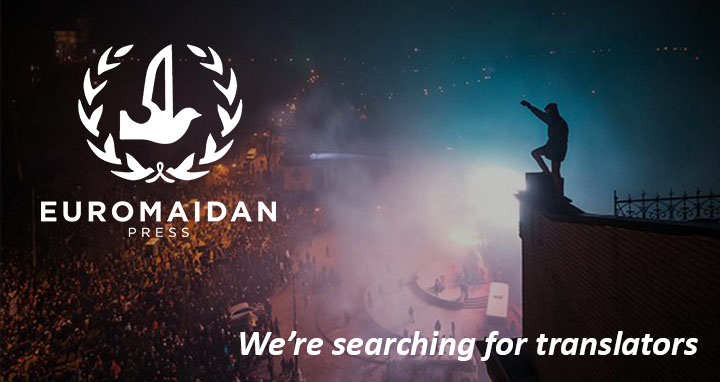“I won’t let the separatists take me alive. I’ve made up my mind: I’d rather be blown to pieces,” Hesha announces in such a matter of fact tone of voice that it’s almost hard to believe him. However, after driving away from the danger zone for a few hours, he reaches under the driver’s seat and shows me a grenade, an F-1. “I guess this won’t be needed for a while,” the driver states in a melancholy voice, then hides his dangerous cargo in the depths of a storage box.”Have you lost your mind,” we blurt out simultaneously.
“Don’t worry about it, it’s more for show. It would be a waste to pull the pin; the main thing is to keep the grenade handy.” By the time the separatists close in on me and figure out what’s happening, I will only have a few seconds to reach for my pistol,” says Hesha a little too lightheartedly. There is really no way of knowing what to make of what he is saying.
An hour earlier we were given a photograph of a group of captured soldiers from the Ukrainian army who were being held prisoner at Savur-Mohyla. The sight of them makes one wonder whether it wouldn’t be better to hope for the best or to pull the pin instead….
Hesha and Volodia are driving us to Donetsk oblast. The trip is uncomfortable: there is a heavy weapon on one’s lap; the trunk and back seat are stuffed with weapons, ammunition, bullet proof vests, and boxes filled with medical supplies. The vests are for us, and everything else is for the fighters. “It will all help ,” explains Volodia.
Recently the army and volunteer soldiers reached an agreement with the enemy for safe passage in the Savur-Mohyla raion for the purpose of recovering the bodies of dead Ukrainian fighters who still remained exposed to the elements.
Their official status until now has been missing, whereabouts unknown. Such a category provides a glimmer of hope for their families, except for the fact that the only real difference between “disappeared” and “perished” is the discovery of a body. A person has a better chance as a prisoner, but even in such a scenario there are many extremes.
“The separatists have a camp for prisoners of war. We know the identity of most of the captives. We have special committees who have made contact with them for prisoner exchanges, and representatives work to reach agreements. Normally there is no point in hiding any information about the soldiers. In other words, if someone cannot be found, it can only mean he is no longer alive,” asserts Hesha.
Give or take a few weeks, just in case you’re wrong and a person suddenly emerges from the battle zone. But otherwise, it’s a lost cause, unless you’re hoping for a miracle.
“There would be no problem if they intended to hold these soldiers for the purpose of a prisoner exchange,” Volodia adds, “but realistically, how many of our own men make it that far?”
We are met by members of the armed forces at a traffic control checkpoint (DAI) a few kilometers from Kurakhovyi. They express their gratitude to us for all the medical supplies and food we have delivered as they transfer everything to their own microbus. However, they do not give us permission to travel beyond that checkpoint.
There has been a change in plans. Yesterday it appeared that an agreement had been reached, but today everything is different. Volunteers to collect bodies can still enter, but not journalists. We are out of luck getting to Savur-Mohyla.
Officers with CIMIC (Civil-Military Cooperation) agree to provide us with updates on the situation in rebel-controlled territory, as well as those raions closest to the theatre of military operations. They are in daily contact with the local population and individuals who volunteer to help the Ukrainian government search for the bodies of dead servicemen. These members of CIMIC assist in the transportation of human remains to the coroners’ offices.
“Ten bodies were most recently delivered to us, recovered from the Savur-Mohyla raion. Nine were our fighters, but the last body belongs to someone who died around the year 2012,” explains Yuri Stoianskyi, a CIMIC officer. This group was transported to the morgue at Krasnoarmisk, then later to Dnipropetrovsk.
These bodies, discovered at field camps around Savur- Mohyla, exhibit the distinctive signs of excruciating torture.
We learned that these Ukrainian military servicemen had been taken into captivity by the separatists. Nearly all the Ukrainian fighters had had their fingers cut off. Additionally, their arms and legs had been broken, and their eyes gouged out; the faces of some had been burned, while the rest of their bodies had been spared the fire. It’s as if someone had purposely taken a blowtorch to their faces as an act of intimidation.
“You can see for yourselves the severed fingers, the dislocated joints, the gunshot wounds on some of them to the shins and knees; hands tied behind their backs. The signs of torture speak for themselves,” says an officer, enumerating the wounds. “Complete sadism.”
The majority of these men were killed when their prison camp came under mortar attack. Only death released these captives from their suffering. Others, however, had died earlier, a fact that was discovered when not only shrapnel, but also small calibre bullets, were removed from their skulls.
“They were executed by a shot to the back of the head. Experts have estimated that up to half these deaths occurred in this manner,” the soldiers tell us.
The experts report that eight of the nine men were privates, and one was an officer. His wounds differed in degree from the others. The extent of the trauma was such that, as if the fingerless hands weren’t enough, for the officer not even the hand remained.
By evening the volunteers had delivered the complete caravan of the dead. The earthly remains of four additional fighters were transported to the station at Chaplyne, on the oblast border between Donetsk and Dnipropetrovsk. The volunteers do not know what will be done with them next since all the available city morgues are overcrowded.
The black bags are transferred from vehicles to railroad car refrigerators. The bodies will be preserved here until such time as there is no room left in them, or until one of the morgues agrees to accept a new shipment of “cargo 200”.
The bodies of these men need to be identified, after which they can be given a proper burial. One of our guides shows us a blue and yellow cloth: “This flag accompanied the men we brought. I imagine they will use it when they bury them; either that or donate it to the best museum around,” he suggested.
It is impossible to ascertain when these bodies will actually make it to the morgue. The reality is that there is no room for the proper preservation of these corpses in most of the surrounding towns. We were also informed that Dnipropetrovsk faces a similar crisis.
Iryna Fedorchuk, the liason officer with the law enforcement authorities of the Dnipropetrovsk oblast administration explained: “All refrigerated space used by coroners are at over-capacity, and the number of bodies is estimated to be in the hundreds. Given the fact that so many bodies are disfigured, it is essential that DNA tests be done to confirm their identity, matched with the genetics of family members. There is no other way to identify the deceased. Such testing can take months…”
Local activists are looking for ways to improve the situation. They also have their own concerns: while it is essential that everything possible be done to provide a dignified burial for the deceased, do not forget that this is also a criminal investigation, with the purpose of future punishment for those guilty in the deaths of out soldiers.
Dnipropetrovsk community activists have compiled a special photo album in order to draw the attention of parliamentarians to the horrors of war. “Too many elected officials and high ranking bureaucrats act as if nothing of this sort is even occurring in our country,” explains Taras Zdrenyk, a representative of the organization, “Dignity and Freedom”.
“It is obvious that the war has not affected their families. It will be our task to awaken the conscience of such people, and we hope our photo album will change their perspective.”
There are currently 450 copies of this photo album in circulation, the same number as there are elected members of the Verkhovna Rada. The activists hope that every elected official will change their understanding of the war after seeing these graphic pictures.
They do wonder about one thing, however: whether the majority of deputies will find within themselves the courage to read the entire book.







